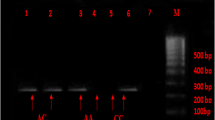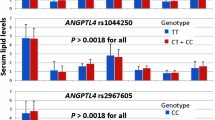Abstract
Objective Atherosclerosis is an inflammatory disease resulting from interactions between various genetic and non-genetic factors. Angiotensinogen gene (AGT) belongs to polymorphic candidate genes. Recent evidence show that many traditional risk factors of coronary artery disease (CAD) influence synthesis of AGT. This report focuses on the interactions between M235T polymorphism of AGT gene and traditional risk factors of CAD. Material and Methods 255 subjects, including 158 patients with angiographically confirmed CAD and 97 blood donors without history of cardiovascular diseases were studied. M235T polymorphism of the AGT gene was genotyped using PCR-RFLP method. To determine the possible interactions of AGT genotypes and traditional risk factors of CAD the attributable proportion due to interaction (AP) and synergy models were used. Results The frequency of 235T allele carriers was significantly higher in patients than in controls (77.8 vs. 62.9, OR = 2.20, 95%CI; 1.10–4.40, P = 0.026, in multivariate logistic regression model). We found the existence of interaction between the 235T allele carrier-state and hypercholesterolemia (total cholesterol ≥5 mmol/l) increasing the risk of CAD (SI = 3.39, 95%CI; 1.33–8.66, AP = 0.65, 95%CI; 0.39–0.91). The 235T allele also interacted with elevated LDL cholesterol levels (≥3 mmol/l) (AP = 0.49, 95%CI; 0.20–0.96), but not with the hypertension, overweight/obesity and cigarette smoking. Conclusion The 235T allele increases the risk of CAD associated with the presence of hypercholesterolemia.
Similar content being viewed by others
Abbreviations
- AGT:
-
Angiotensinogen
- AP:
-
Attributable proportion due to interaction
- CAD:
-
Coronary artery disease
- LDL:
-
Low density cholesterol lipoprotein
- Ox-LDL:
-
Oxidized low density cholesterol lipoprotein
- RAS:
-
Renin angiotensin system
- SI:
-
Synergy index
- TC:
-
Total cholesterol
References
Ross R. Atherosclerosis—an inflammatory disease. N Engl J Med. 1999;340(2):115–26.
Touyz RM, Schiffrin EL. Signal transduction mechanisms mediating the physiological and pathophysiological actions of angiotensin II in vascular smooth muscle cells. Pharmacol Rev. 2000;52(4):639–72.
Griendling KK, Sorescu D, Ushio-Fukai M. NAD(P)H oxidase: role in cardiovascular biology and disease. Circ Res. 2000;86(5):494–501.
Lassegue B, Clempus RE. Vascular NAD(P)H oxidases: specific features, expression, and regulation. Am J Physiol Regul Integr Comp Physiol. 2003;285(2):R277–97.
Fukamizu A, Takahashi S, Seo MS, Tada M, Tanimoto K, Uehara S, et al. Structure and expression of the human angiotensinogen gene. Identification of a unique and highly active promoter. J Biol Chem. 1990;265(13):7576–82.
Jeunemaitre X, Soubrier F, Kotelevtsev YV, Lifton RP, Williams CS, Charru A, et al. Molecular basis of human hypertension: role of angiotensinogen. Cell. 1992;71(1):169–80.
Sethi AA, Nordestgaard BG, Tybjaerg-Hansen A. Angiotensinogen gene polymorphism, plasma angiotensinogen, and risk of hypertension and ischemic heart disease: a meta-analysis. Arterioscler Thromb Vasc Biol. 2003;23(7):1269–75.
Jeunemaitre X, Ledru F, Battaglia S, Guillanneuf MT, Courbon D, Dumont C, et al. Genetic polymorphisms of the renin-angiotensin system and angiographic extent and severity of coronary artery disease: the CORGENE study. Hum Genet. 1997;99(1):66–73.
Batalla A, Alvarez R, Reguero JR, Hevia S, Iglesias-Cubero G, Alvarez V, et al. Synergistic effect between apolipoprotein E and angiotensinogen gene polymorphisms in the risk for early myocardial infarction. Clin Chem. 2000;46(12):1910–5.
Rodriguez-Perez JC, Rodriguez-Esparragon F, Hernandez-Perera O, Anabitarte A, Losada A, Medina A, et al. Association of angiotensinogen M235T and A(−6) G gene polymorphisms with coronary heart disease with independence of essential hypertension: the PROCAGENE study. Prospective Cardiac Gene. J Am Coll Cardiol. 2001;37(6):1536–42.
Takakura Y, Yoshida T, Yoshioka K, Umekawa T, Kogure A, Toda H, et al. Angiotensinogen gene polymorphism (Met235Thr) influences visceral obesity and insulin resistance in obese Japanese women. Metabolism. 2006;55(6):819–24.
Daugherty A, Rateri DL, Lu H, Inagami T, Cassis LA. Hypercholesterolemia stimulates angiotensin peptide synthesis and contributes to atherosclerosis through the AT1A receptor. Circulation. 2004;110(25):3849–57.
Yang BC, Phillips MI, Mohuczy D, Meng H, Shen L, Mehta P, et al. Increased angiotensin II type 1 receptor expression in hypercholesterolemic atherosclerosis in rabbits. Arterioscler Thromb Vasc Biol. 1998;18(9):1433–9.
Rahmouni K, Mark AL, Haynes WG, Sigmund CD. Adipose depot-specific modulation of angiotensinogen gene expression in diet-induced obesity. Am J Physiol Endocrinol Metab. 2004;286(6):E891–5.
Van Harmelen V, Ariapart P, Hoffstedt J, Lundkvist I, Bringman S, Arner P. Increased adipose angiotensinogen gene expression in human obesity. Obes Res. 2000;8(4):337–41.
Zhang S, Day I, Ye S. Nicotine induced changes in gene expression by human coronary artery endothelial cells. Atherosclerosis. 2001;154(2):277–83.
Saijonmaa O, Nyman T, Fyhrquist F. Regulation of angiotensin-converting enzyme production by nicotine in human endothelial cells. Am J Physiol Heart Circ Physiol. 2005;289(5):H2000–4.
Zak I, Balcerzyk A, Sarecka B, Niemiec P, Ciemniewski Z, Dylag S. Contemporaneous carrier-state of two or three “proatherosclerotic” variants of APOE, ICAM1, PPARA and PAI-1 genes differentiate CAD patients from healthy individuals. Clin Chim Acta. 2005;362(1–2):110–8.
De Backer G, Ambrosioni E, Borch-Johnsen K, Brotons C, Cifkova R, Dallongeville J, et al. European Society of Cardiology. American Heart Association. American College of Cardiology. European guidelines on cardiovascular disease prevention in clinical practice. Third Joint Task Force of European and other Societies on Cardiovascular Disease Prevention in Clinical Practice (constituted by representatives of eight societies and by invited experts). Atherosclerosis. 2004;173(2):381–91.
Alpert JS, Thygesen K, Antman E, Bassand JP. Myocardial infarction redefined-a consensus document of The Joint European Society of Cardiology/American College of Cardiology Committee for the redefinition of myocardial infarction. J Am Coll Cardiol. 2000;36(3):959–69.
Friedewald WT, Levy RI, Fredrickson DS. Estimation of the concentration of low-density lipoprotein cholesterol in plasma, without use of the preparative ultracentrifuge. Clin Chem. 1972;18(6):499–502.
Assmann SF, Hosmer DW, Lemeshow S, Mundt KA. Confidence intervals for measures of interaction. Epidemiology. 1996;7(3):286–90.
Lundberg M, Fredlund P, Hallqvist J, Diderichsen F. A SAS program calculating three measures of interaction with confidence intervals. Epidemiology. 1996;7(6):655–6.
Park SY, Song CY, Kim BC, Hong HK, Lee HS. Angiotensin II mediates LDL-induced superoxide generation in mesangial cells. Am J Physiol Renal Physiol. 2003;285(5):F909–15.
Nickenig G, Sachinidis A, Seewald S, Bohm M, Vetter H. Influence of oxidized low-density lipoprotein on vascular angiotensin II receptor expression. J Hypertens Suppl. 1997;15(6):S27–30.
Nickenig G, Sachinidis A, Michaelsen F, Bohm M, Seewald S, Vetter H. Upregulation of vascular angiotensin II receptor gene expression by low-density lipoprotein in vascular smooth muscle cells. Circulation. 1997;95(2):473–8.
Watanabe T, Pakala R, Katagiri T, Benedict CR. Mildly oxidized low-density lipoprotein acts synergistically with angiotensin II in inducing vascular smooth muscle cell proliferation. J Hypertens. 2001;19(6):1065–73.
Aviram M, Rosenblat M, Etzioni A, Levy R. Activation of NADPH oxidase required for macrophage-mediated oxidation of low-density lipoprotein. Metabolism. 1996;45(9):1069–79.
Azumi H, Inoue N, Ohashi Y, Terashima M, Mori T, Fujita H, et al. Superoxide generation in directional coronary atherectomy specimens of patients with angina pectoris: important role of NAD(P)H oxidase. Arterioscler Thromb Vasc Biol. 2002;22(11):1838–44.
Rueckschloss U, Galle J, Holtz J, Zerkowski HR, Morawietz H. Induction of NAD(P)H oxidase by oxidized low-density lipoprotein in human endothelial cells: antioxidative potential of hydroxymethylglutaryl coenzyme A reductase inhibitor therapy. Circulation. 2001;104(15):1767–72.
Chen J, Li D, Schaefer R, Mehta JL. Cross-talk between dyslipidemia and renin-angiotensin system and the role of LOX-1 and MAPK in atherogenesis studies with the combined use of rosuvastatin and candesartan. Atherosclerosis. 2006;184(2):295–301.
Massiera F, Bloch-Faure M, Ceiler D, Murakami K, Fukamizu A, Gasc JM, et al. Adipose angiotensinogen is involved in adipose tissue growth and blood pressure regulation. FASEB J. 2001;15(14):2727–9.
Acknowledgement
Supported by the Medical University of Silesia within the projects: NN-2-102/05 and NN-2-016/06.
Author information
Authors and Affiliations
Corresponding author
Rights and permissions
About this article
Cite this article
Niemiec, P., Zak, I. & Wita, K. The M235T polymorphism of the AGT gene modifies the risk of coronary artery disease associated with the presence of hypercholesterolemia. Eur J Epidemiol 23, 349–354 (2008). https://doi.org/10.1007/s10654-008-9241-7
Received:
Accepted:
Published:
Issue Date:
DOI: https://doi.org/10.1007/s10654-008-9241-7




